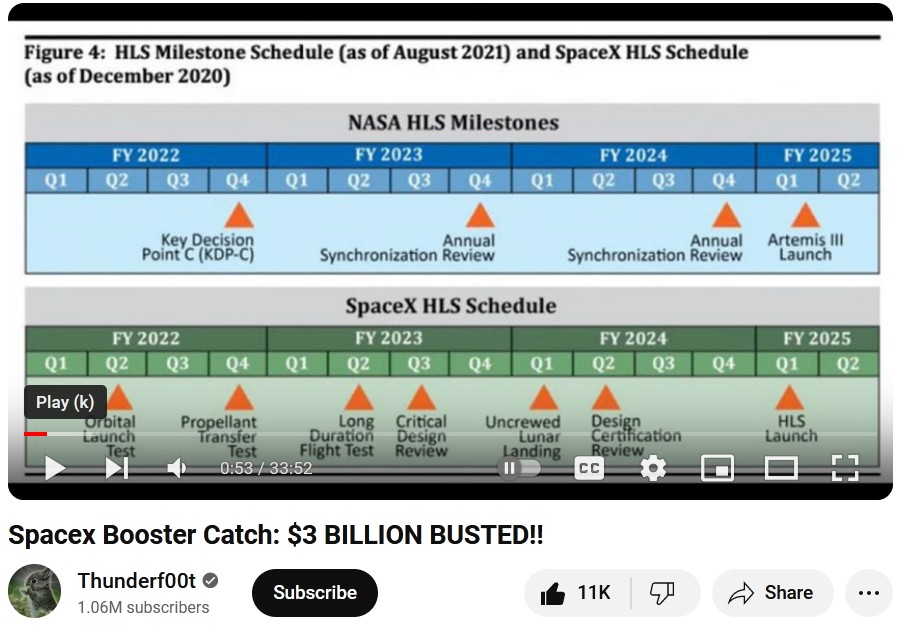It looks like you're using an Ad Blocker.
Please white-list or disable AboveTopSecret.com in your ad-blocking tool.
Thank you.
Some features of ATS will be disabled while you continue to use an ad-blocker.
share:
Amazing that California (Newsome) is cancelling SpaceX launches because they don't like Musk's tweets.
I have had occasion to work in a few Space X-affiliated facilities over the last two years and have noticed something that appears to be a common
trait among all of their personnel. From the guys at the security post to the engineers with whom I have interacted, Space X employees seem to LOVE
being told “that is not possible”.
“That is not possible” is not a statement in their world. It’s a challenge, and those guys (and girls) LOVE to enumerate and demonstrate all the ways that whoever makes that statement/challenge is wrong. Bonus point for them because they don’t just TELL you that you are mistaken, they end up showing you, then offering a laundry list of ways and methods one may approach and overcome the impossible in future endeavors.
As companies go, the culture that has been cultivated at Space X really is one that a lot of other companies, technical or not, could learn from.
“That is not possible” is not a statement in their world. It’s a challenge, and those guys (and girls) LOVE to enumerate and demonstrate all the ways that whoever makes that statement/challenge is wrong. Bonus point for them because they don’t just TELL you that you are mistaken, they end up showing you, then offering a laundry list of ways and methods one may approach and overcome the impossible in future endeavors.
As companies go, the culture that has been cultivated at Space X really is one that a lot of other companies, technical or not, could learn from.
edit on 14-10-2024 by FloridaManMatty because: Typo
a reply to: gortex
It's amazing what this man does from self driving cars , optimus autonomous robotics, high speed trains underground and now this a starship that could hold hundred astronauts bringing them to space and completely reusable and autonomous landing a booster back to the launch pad
What's next
It's amazing what this man does from self driving cars , optimus autonomous robotics, high speed trains underground and now this a starship that could hold hundred astronauts bringing them to space and completely reusable and autonomous landing a booster back to the launch pad
What's next
WoW.. that was amazing to watch... "Tips hat to spaceX"
All the best
All the best
Without Space X, we would be behind NK at this point with technology to get into Space. The fact they have rescued the other largest US based
contractor, are actively providing internet to worn-torn or storm ravaged areas and just had more announcements is amazing. There was a time in the US
we were in the lead and again, if not for this team we would not be.
The robots we just saw? Wondering if they are going to be on that first trip to Mars. That would be incredible.
This launch, to me, was beyond amazing. It truly is Sci-Fi and our country has been missing that. To busy with identity politics and division instead of creating a new generation of dreamers.
The robots we just saw? Wondering if they are going to be on that first trip to Mars. That would be incredible.
This launch, to me, was beyond amazing. It truly is Sci-Fi and our country has been missing that. To busy with identity politics and division instead of creating a new generation of dreamers.
a reply to: gortex
I am just sayin', that Elon Musk supporting Trump, the recent Tucker interview and now this absolutely remarkable feat....yea, Trump via the genius of Elon Musk and the full endorsement of Trump by said genius....I think that feat just won the election. Thank you Elon! Ow yea, and before you say it, yes!, it is all politicized. Without a country and all the rights that go along with the bill of rights & the constitution you wouldn't have this achievement. Just remember this is the guy that made that possible, that made that happen.
I am just sayin', that Elon Musk supporting Trump, the recent Tucker interview and now this absolutely remarkable feat....yea, Trump via the genius of Elon Musk and the full endorsement of Trump by said genius....I think that feat just won the election. Thank you Elon! Ow yea, and before you say it, yes!, it is all politicized. Without a country and all the rights that go along with the bill of rights & the constitution you wouldn't have this achievement. Just remember this is the guy that made that possible, that made that happen.
edit on 14-10-2024 by fringeofthefringe because: Update
originally posted by: CarlLaFong
Amazing that California (Newsome) is cancelling SpaceX launches because they don't like Musk's tweets.
One day Newsom will wake up and realize playing the part
of the jilted lover is going to be just like sour grapes from
his vineyards. Then he will run to Aunt Nancy and beg for
redemption, once again. Even so, being on the wrong side
of history, it is just not a good look.
How could he be so shortsighted?
This accomplishment is so far beyond the measure
of petty politics, and exactly why people who engage
in such stunted behavior hold back the progress of
the future.
But yeah, "lets ban plastic bags, that will do it"!
edit on 14-10-2024 by burntheships because: (no reason given)
I noticed some of the people commenting here are not US taxpayers so I can see why you might be impressed with the engineering if you didn't get far
less from spaceX than you were supposed to, for the $3 billion they were given. This event was so insignificant, it didn't even get a milestone on the
project plan chart that SpaceX submitted years ago:

What SpaceX was supposed to deliver for $3 billion was to land the HLS spaceship on the moon, but they accomplished almost none of the goals they were supposed to accomplish toward this objective. So the US taxpayers paid $3 billion for what is shown on the left, but what they got for $3 billion is what is shown on the right, which arguably isn't even worth $1 Billion, probably far less.

Those screenshots are from this video by youtuber Thunderf00t, released about 1 day ago as I post this.
Spacex Booster Catch: $3 BILLION BUSTED!!
To calibrate what $3 billion can get, he points out that the nuclear powered Perseverance robot landed on mars with all kinds of advanced science instruments for $2.5 billion, and that earlier solar powered rovers only cost $400 million each to send to Mars so 3 billion dollars would send 6 of those to Mars, but I fact checked that claim, it was actually 420 million instead of 400 million, still pretty close (and there's been inflation since then which should be considered):
The Cost of NASA's Phoenix Mission to Mars
Maybe he wasn't counting the $12.6 million for the mission since he was talking about what it cost to build the spacecraft and land it on Mars, which was actually $407 million, pretty close to his $400 million.
He also mentions the Delta Clipper resuable rocket test in 1993 which landed upright back at its landing point (though it's not as big as what SpaceX recovered), so it's not like this event is completely unprecedented.
McDonnell Douglas DC-X Test Flight | A Push for Reusable Launch Vehicles | 1993
Those who don't learn history are doomed to repeat it, and it seems to me like we are repeating history here with promises of an economical, re-usable space shuttle that was never economical even though it was re-usable. (It cost about 1.5 billion dollars per launch, and we could have accomplished far more with non-re-usable rockets than we did with the space shuttle, which is one reason the space shuttle program was shut down).
Doesn't it seem like we are repeating history, and learning the same lessons over again that re-using rockets is not economical? At least nobody has ever proven it's economical, and the economics of Space-X are a complete disaster, when you compare what they were contractually obligated to provide (a moon landing), versus what they actually delivered, which looks a lot like a larger version of the Delta Clipper test of re-landing an upright rocket 31 years ago in 1993.

What SpaceX was supposed to deliver for $3 billion was to land the HLS spaceship on the moon, but they accomplished almost none of the goals they were supposed to accomplish toward this objective. So the US taxpayers paid $3 billion for what is shown on the left, but what they got for $3 billion is what is shown on the right, which arguably isn't even worth $1 Billion, probably far less.

Those screenshots are from this video by youtuber Thunderf00t, released about 1 day ago as I post this.
Spacex Booster Catch: $3 BILLION BUSTED!!
To calibrate what $3 billion can get, he points out that the nuclear powered Perseverance robot landed on mars with all kinds of advanced science instruments for $2.5 billion, and that earlier solar powered rovers only cost $400 million each to send to Mars so 3 billion dollars would send 6 of those to Mars, but I fact checked that claim, it was actually 420 million instead of 400 million, still pretty close (and there's been inflation since then which should be considered):
The Cost of NASA's Phoenix Mission to Mars
The Phoenix mission cost $420 million. Of this total, $321 million was for spacecraft development, $86.2 million was for its launch, and $12.6 million was for its primary mission
Maybe he wasn't counting the $12.6 million for the mission since he was talking about what it cost to build the spacecraft and land it on Mars, which was actually $407 million, pretty close to his $400 million.
He also mentions the Delta Clipper resuable rocket test in 1993 which landed upright back at its landing point (though it's not as big as what SpaceX recovered), so it's not like this event is completely unprecedented.
McDonnell Douglas DC-X Test Flight | A Push for Reusable Launch Vehicles | 1993
Plane science is somewhat different from rocket science. The Space shuttle was re-usable but it never met the supposed economic goals because the issues with re-using spacecraft were underestimated, and they are likely still being underestimated by Space-X. For a dive into rocket recovery economics, watch the $3 BILLION BUSTED!! video at time index 14 minutes, though he doesn't get into the actual figures until about 19:55.
originally posted by: Oldcarpy2
Imagine how expensive it would be to fly between say the UK to the US if the plane has to be scrapped when it got there.
That's the thing.
Those who don't learn history are doomed to repeat it, and it seems to me like we are repeating history here with promises of an economical, re-usable space shuttle that was never economical even though it was re-usable. (It cost about 1.5 billion dollars per launch, and we could have accomplished far more with non-re-usable rockets than we did with the space shuttle, which is one reason the space shuttle program was shut down).
Doesn't it seem like we are repeating history, and learning the same lessons over again that re-using rockets is not economical? At least nobody has ever proven it's economical, and the economics of Space-X are a complete disaster, when you compare what they were contractually obligated to provide (a moon landing), versus what they actually delivered, which looks a lot like a larger version of the Delta Clipper test of re-landing an upright rocket 31 years ago in 1993.
edit on 20241020 by Arbitrageur because: clarification
Starship's 6th test flight is scheduled for launch on Tuesday 19th with the prospect of a 2nd successful catch of the Super Heavy booster.
Just one month since the last test , petty impressive.
Starship’s fifth flight test was a seminal moment in iterating towards a fully and rapidly reusable launch system. On the first attempt, the Super Heavy booster successfully returned to the launch site and was caught by the chopstick arms of the launch and catch tower at Starbase. Starship’s upper stage went on to demonstrate several improvements, resulting in a controlled entry and high accuracy splashdown at the targeted area in the Indian Ocean.
The next Starship flight test aims to expand the envelope on ship and booster capabilities and get closer to bringing reuse of the entire system online. Objectives include the booster once again returning to the launch site for catch, reigniting a ship Raptor engine while in space, and testing a suite of heatshield experiments and maneuvering changes for ship reentry and descent over the Indian Ocean.
The success of the first catch attempt demonstrated the design feasibility while providing valuable data to continue improving hardware and software performance. Hardware upgrades for this flight add additional redundancy to booster propulsion systems, increase structural strength at key areas, and shorten the timeline to offload propellants from the booster following a successful catch. Mission designers also updated software controls and commit criteria for the booster’s launch and return.
www.spacex.com...
Just one month since the last test , petty impressive.
new topics
-
Driving home for Christmas… fast!
General Entertainment: 4 minutes ago -
My Retirement
General Chit Chat: 58 minutes ago -
‘Something horrible’: Somerset pit reveals bronze age cannibalism
Ancient & Lost Civilizations: 2 hours ago -
Spiritual Solstice
Short Stories: 4 hours ago
top topics
-
'Mass Casualty event' - Attack at Christmas market in Germany
Mainstream News: 14 hours ago, 27 flags -
Search to Resume for MH 370
Disaster Conspiracies: 16 hours ago, 5 flags -
My Retirement
General Chit Chat: 58 minutes ago, 4 flags -
‘Something horrible’: Somerset pit reveals bronze age cannibalism
Ancient & Lost Civilizations: 2 hours ago, 1 flags -
Spiritual Solstice
Short Stories: 4 hours ago, 0 flags -
Driving home for Christmas… fast!
General Entertainment: 4 minutes ago, 0 flags
active topics
-
My Retirement
General Chit Chat • 3 • : gortex -
Driving home for Christmas… fast!
General Entertainment • 0 • : gortex -
Drone Shooting Arrest - Walmart Involved
Mainstream News • 40 • : Lazy88 -
The Truth Behind the Manchester Airport "Police Assault" Video
Social Issues and Civil Unrest • 57 • : gortex -
Biden Nationalizes Another 50,000+ Student Loans as He Heads for the Exit
US Political Madness • 14 • : butcherguy -
'Mass Casualty event' - Attack at Christmas market in Germany
Mainstream News • 107 • : cherokeetroy -
‘Something horrible’: Somerset pit reveals bronze age cannibalism
Ancient & Lost Civilizations • 1 • : Naftalin -
Sue Gray, Sir Keir Starmer's former Chief of Staff, Nominated for Peerage
Regional Politics • 3 • : Freeborn -
Search to Resume for MH 370
Disaster Conspiracies • 8 • : charlyv -
Spiritual Solstice
Short Stories • 2 • : Naftalin


